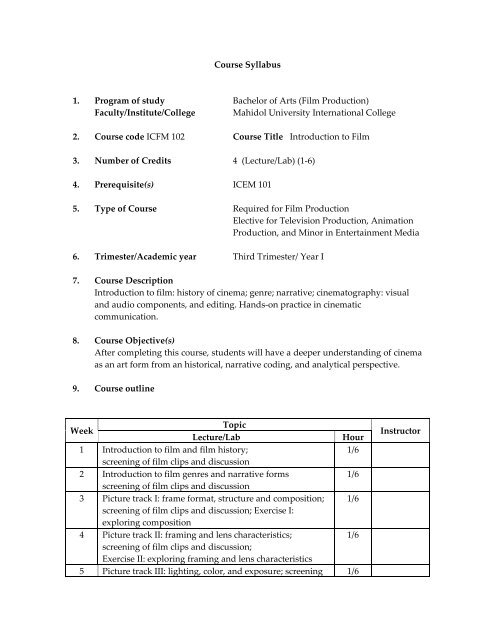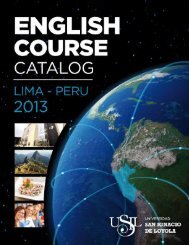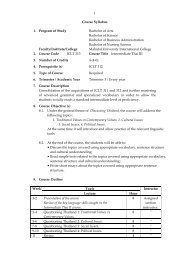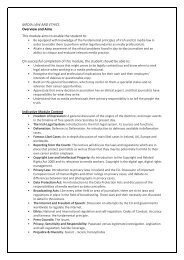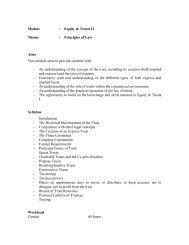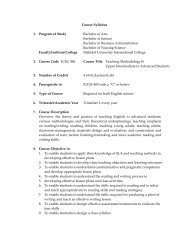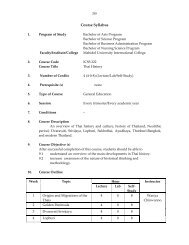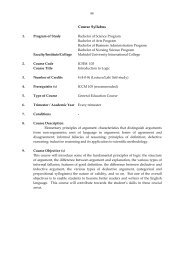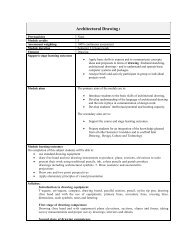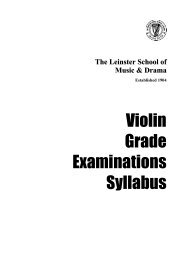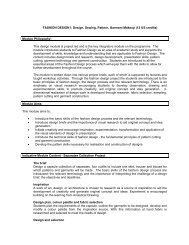ICFM 102 Introduction to Film - KEI
ICFM 102 Introduction to Film - KEI
ICFM 102 Introduction to Film - KEI
Create successful ePaper yourself
Turn your PDF publications into a flip-book with our unique Google optimized e-Paper software.
Course Syllabus<br />
1. Program of study Bachelor of Arts (<strong>Film</strong> Production)<br />
Faculty/Institute/College Mahidol University International College<br />
2. Course code <strong>ICFM</strong> <strong>102</strong> Course Title <strong>Introduction</strong> <strong>to</strong> <strong>Film</strong><br />
3. Number of Credits 4 (Lecture/Lab) (1‐6)<br />
4. Prerequisite(s) ICEM 101<br />
5. Type of Course Required for <strong>Film</strong> Production<br />
Elective for Television Production, Animation<br />
Production, and Minor in Entertainment Media<br />
6. Trimester/Academic year Third Trimester/ Year I<br />
7. Course Description<br />
<strong>Introduction</strong> <strong>to</strong> film: his<strong>to</strong>ry of cinema; genre; narrative; cinema<strong>to</strong>graphy: visual<br />
and audio components, and editing. Hands‐on practice in cinematic<br />
communication.<br />
8. Course Objective(s)<br />
After completing this course, students will have a deeper understanding of cinema<br />
as an art form from an his<strong>to</strong>rical, narrative coding, and analytical perspective.<br />
9. Course outline<br />
Week<br />
Topic<br />
Lecture/Lab<br />
Hour<br />
1 <strong>Introduction</strong> <strong>to</strong> film and film his<strong>to</strong>ry;<br />
1/6<br />
screening of film clips and discussion<br />
2 <strong>Introduction</strong> <strong>to</strong> film genres and narrative forms<br />
1/6<br />
screening of film clips and discussion<br />
3 Picture track I: frame format, structure and composition; 1/6<br />
screening of film clips and discussion; Exercise I:<br />
exploring composition<br />
4 Picture track II: framing and lens characteristics;<br />
1/6<br />
screening of film clips and discussion;<br />
Exercise II: exploring framing and lens characteristics<br />
5 Picture track III: lighting, color, and exposure; screening 1/6<br />
Instruc<strong>to</strong>r
of film clips and discussion;<br />
Exercise III: exploring lighting, color, and exposure<br />
6 Picture track IV: kinetic form of a shot; screening of film 1/6<br />
clips and discussion;<br />
Exercise IV: exploring the kinetic form of a shot<br />
7 Sound track I: sound track components; screening of film 1/6<br />
clips and discussion;<br />
Exercise V: exploring the sound track components<br />
8 <strong>Introduction</strong> <strong>to</strong> visual editing: levels of editing;<br />
1/6<br />
long take shot vs multiple shot sequence;<br />
screening of film clips and discussion;<br />
Assignment of final project<br />
9 Functions of visual editing: syntactic, semantic, and 1/6<br />
rhythmic; screening of film clips and discussion;<br />
Exercise VI: exploring the functions of visual editing<br />
10 <strong>Introduction</strong> <strong>to</strong> sound editing: similarities/differences 1/6<br />
from visual editing; screening of film clips and<br />
discussion;<br />
Exercise VII: exploring the basics of sound editing<br />
11 Relationship between picture and sound track:<br />
1/6<br />
redundancy, complementarities, and au<strong>to</strong>nomy;<br />
screening of film clips & discussion<br />
12 Final exam<br />
1/6<br />
Final project presentation and critique<br />
Total 12/72<br />
10. Teaching Method(s)<br />
Lecture and hands‐on practice<br />
11. Teaching Media<br />
Video cameras and editing stations<br />
12. Measurement and evaluation of student achievement<br />
Assessment is made from the criteria of A, B+, B, C+, C, D+ and D<br />
13. Course evaluation<br />
Exercises 50%<br />
Final project 20%<br />
Final exam 30%<br />
14. Reference(s)<br />
Honthaner, E. (2001). <strong>Introduction</strong> <strong>to</strong> <strong>Film</strong>. Focal Press.
15. Instruc<strong>to</strong>r(s)<br />
TBA<br />
16. Course Coordina<strong>to</strong>r<br />
Sarunya Noithai


